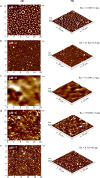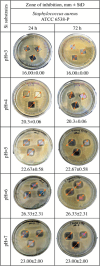Investigation of Antibacterial Coatings Based on Chitosan/Polyacrylic Acid/Chlorhexidine for Orthopedic Implants
- PMID: 39679059
- PMCID: PMC11638784
- DOI: 10.1021/acspolymersau.4c00049
Investigation of Antibacterial Coatings Based on Chitosan/Polyacrylic Acid/Chlorhexidine for Orthopedic Implants
Abstract
Antibacterial coatings on model silicon wafers and implants, based on chitosan (CHI), poly(acrylic acid) (PAA), and the antibacterial agent chlorhexidine digluconate (CHX), were obtained using a layer-by-layer assembly method. The surface roughness and 2D and 3D images of the surfaces of CHI/PAA/CHX coatings obtained from different pH assemblies were investigated by atomic force microscopy, revealing that pH 6 enabled optimal inclusion of CHX in the multilayer film. The structure and elemental composition before and after implementation of CHX into the coating were investigated via scanning electron microscopy and energy-dispersive X-ray spectroscopy. The obtained films exhibited antimicrobial efficacy against Staphylococcus aureus and Staphylococcus epidermidis. The effects of CHX concentration and duration of contact with the coating on bacterial activity were investigated, and the quantitative release of CHX from coated implants in phosphate buffer was determined as a function of the incubation time. The biocompatibility of the PAA/CHI/CHX coatings was investigated using human mononuclear cells (HMNCs) and quantified using an MTT assay. HMNCs demonstrated high viability in eluted solutions obtained from implants coated with PAA/CHI/CHX (0.025%) and PAA/CHI/CHX (0.0125%), while the extract of implants coated with PAA/CHI/CHX (0.05%) induced slight cytotoxicity.
© 2024 The Authors. Published by American Chemical Society.
Conflict of interest statement
The authors declare no competing financial interest.
Figures











Similar articles
-
Development of an anti-infective coating on the surface of intraosseous implants responsive to enzymes and bacteria.J Nanobiotechnology. 2021 Aug 12;19(1):241. doi: 10.1186/s12951-021-00985-3. J Nanobiotechnology. 2021. PMID: 34384446 Free PMC article.
-
Synthesis of multifunctional chlorhexidine-doped thin films for titanium-based implant materials.Mater Sci Eng C Mater Biol Appl. 2020 Dec;117:111289. doi: 10.1016/j.msec.2020.111289. Epub 2020 Jul 24. Mater Sci Eng C Mater Biol Appl. 2020. PMID: 32919650
-
In vitro assessment of an antibacterial quaternary ammonium-based polymer loaded with chlorhexidine for the coating of polypropylene prosthetic meshes.Hernia. 2016 Dec;20(6):869-878. doi: 10.1007/s10029-016-1537-z. Epub 2016 Sep 2. Hernia. 2016. PMID: 27590327
-
Competitive Adsorption of Polyelectrolytes onto and into Pellicle-Coated Hydroxyapatite Investigated by QCM-D and Force Spectroscopy.ACS Appl Mater Interfaces. 2017 Apr 19;9(15):13079-13091. doi: 10.1021/acsami.7b02774. Epub 2017 Apr 5. ACS Appl Mater Interfaces. 2017. PMID: 28332813
-
Two-Dimensional Materials/Biopolymer-Based Antimicrobial Coatings to Thwart Biofilm Formation on Medical Implants.ACS Appl Bio Mater. 2024 Oct 21;7(10):6332-6342. doi: 10.1021/acsabm.4c00725. Epub 2024 Sep 21. ACS Appl Bio Mater. 2024. PMID: 39305253 Review.
Cited by
-
Antimicrobial efficacy of chlorhexidine-treated surfaces against clinical isolates implicated in nosocomial infections.J Med Microbiol. 2025 Jun;74(6):002025. doi: 10.1099/jmm.0.002025. J Med Microbiol. 2025. PMID: 40554546 Free PMC article.
-
Synthesis and Antibacterial Evaluation of Chlorhexidine- and Triclosan-Impregnated Kaolinite Nanocomposites.Materials (Basel). 2025 Jan 3;18(1):174. doi: 10.3390/ma18010174. Materials (Basel). 2025. PMID: 39795819 Free PMC article.
-
Elastin-like polypeptide and triclosan-modified PCL membrane provides aseptic protection in tissue regeneration.Mater Today Bio. 2025 Jun 10;33:101968. doi: 10.1016/j.mtbio.2025.101968. eCollection 2025 Aug. Mater Today Bio. 2025. PMID: 40575653 Free PMC article.
-
Design and Characterization of PAA/CHI/Triclosan Multilayer Films with Long-Term Antibacterial Activity.Polymers (Basel). 2025 Jun 27;17(13):1789. doi: 10.3390/polym17131789. Polymers (Basel). 2025. PMID: 40647799 Free PMC article.
References
-
- Udduttula A.; Jakubovics N.; Khan I.; Pontiroli L.; Rankin K. S.; Gentile P.; Ferreira A. M. Layer-by-Layer Coatings of Collagen–Hyaluronic Acid Loaded with an Antibacterial Manuka Honey Bioactive Compound to Fight Metallic Implant Infections. ACS Appl. Mater. Interfaces 2023, 15 (50), 58119–58135. 10.1021/acsami.3c11910. - DOI - PMC - PubMed
LinkOut - more resources
Full Text Sources
Molecular Biology Databases
